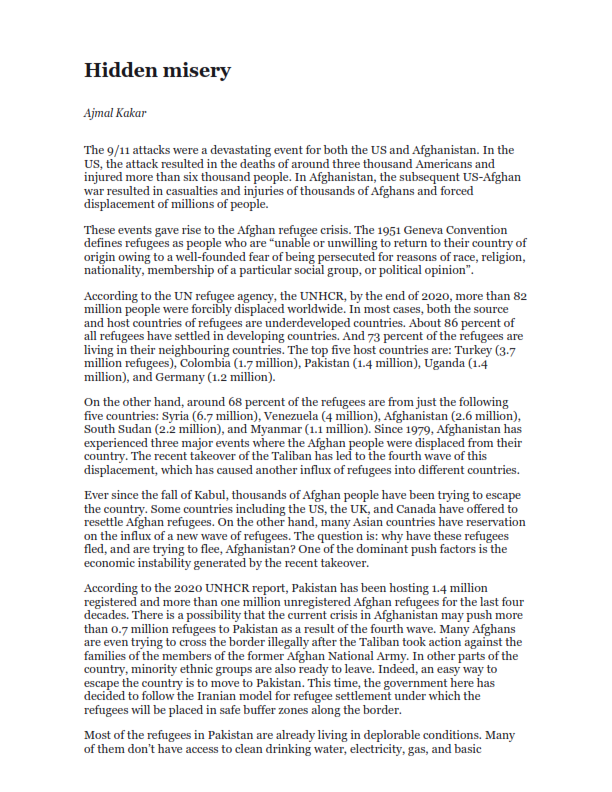
Pakistan Institute of Development Economics
- Home
Our Portals
MenuMenuMenuMenuMenuMenuMenu - ResearchMenuMenuMenuMenuMenuMenuMenu
- Discourse
- The PDR
- Our Researchers
- Academics
- Degree Verification
- Thesis Portal
- Our Portals
Hidden misery
The 9/11 attacks were a devastating event for both the US and Afghanistan. In the US, the attack resulted in the deaths of around three thousand Americans and injured more than six thousand people. In Afghanistan, the subsequent US-Afghan war resulted in casualties and injuries of thousands of Afghans and forced displacement of millions of people.
These events gave rise to the Afghan refugee crisis. The 1951 Geneva Convention defines refugees as people who are “unable or unwilling to return to their country of origin owing to a well-founded fear of being persecuted for reasons of race, religion, nationality, membership of a particular social group, or political opinion”.
According to the UN refugee agency, the UNHCR, by the end of 2020, more than 82 million people were forcibly displaced worldwide. In most cases, both the source and host countries of refugees are underdeveloped countries. About 86 percent of all refugees have settled in developing countries. And 73 percent of the refugees are living in their neighbouring countries. The top five host countries are: Turkey (3.7 million refugees), Colombia (1.7 million), Pakistan (1.4 million), Uganda (1.4 million), and Germany (1.2 million).
On the other hand, around 68 percent of the refugees are from just the following five countries: Syria (6.7 million), Venezuela (4 million), Afghanistan (2.6 million), South Sudan (2.2 million), and Myanmar (1.1 million). Since 1979, Afghanistan has experienced three major events where the Afghan people were displaced from their country. The recent takeover of the Taliban has led to the fourth wave of this displacement, which has caused another influx of refugees into different countries.
Ever since the fall of Kabul, thousands of Afghan people have been trying to escape the country. Some countries including the US, the UK, and Canada have offered to resettle Afghan refugees. On the other hand, many Asian countries have reservation on the influx of a new wave of refugees. The question is: why have these refugees fled, and are trying to flee, Afghanistan? One of the dominant push factors is the economic instability generated by the recent takeover.
According to the 2020 UNHCR report, Pakistan has been hosting 1.4 million registered and more than one million unregistered Afghan refugees for the last four decades. There is a possibility that the current crisis in Afghanistan may push more than 0.7 million refugees to Pakistan as a result of the fourth wave. Many Afghans are even trying to cross the border illegally after the Taliban took action against the families of the members of the former Afghan National Army. In other parts of the country, minority ethnic groups are also ready to leave. Indeed, an easy way to escape the country is to move to Pakistan. This time, the government here has decided to follow the Iranian model for refugee settlement under which the refugees will be placed in safe buffer zones along the border.
Most of the refugees in Pakistan are already living in deplorable conditions. Many of them don’t have access to clean drinking water, electricity, gas, and basic healthcare facilities. A majority of them have no proof of their Afghan nationality and are living as stateless persons. Many Afghan refugee artisans work in the informal sector here and receive less than the minimum wage. And even though the authorities concerned have allocated land for the rehabilitation of refugees, a large majority of them still live on rent.
Many children, who came or were born here as refugees, are not enrolled in either public or private schools. It should be noted that there are schools in Pakistan that were exclusively set up for refugees and that provide low-cost education, many parents remain reluctant to send their children to these schools. As a result, a majority of these children remain vulnerable to child labour.
Among these refugees, more girls are victims of child labour than boys and have to bear the burden of tiring work outside their homes. These social indicators shed light on the devastating situation of a majority of Afghan refugees living here. There is no denying that Pakistan has safely hosted millions of Afghan refugees for decades.
But it is also true that their standard of living isn’t satisfactory. The influx of refugees will create more challenges for the government and other stakeholders such as the UNHCR. They have to come up with a coherent plan to accommodate Afghan refugees on a humanitarian basis. Also, it is the moral responsibility of the US to host these Afghan refugees, especially those who assisted it and its allies in their military and reconstruction efforts in Afghanistan.
These people took the risk to help Americans and their allies stay safe. Their assistance, undoubtedly, had been vital for the US army. Also, the international community should provide aid to those countries which are hosting these refugees.
The writer is a freelance contributor.
Email: [email protected]



